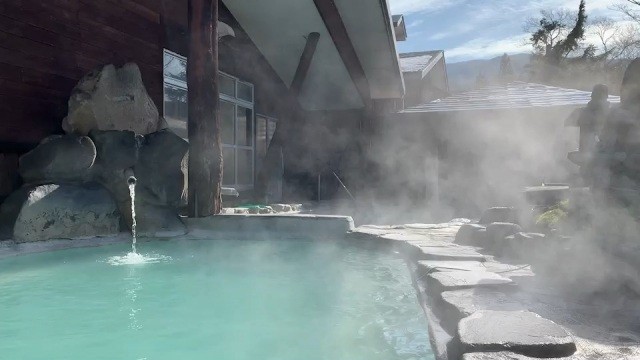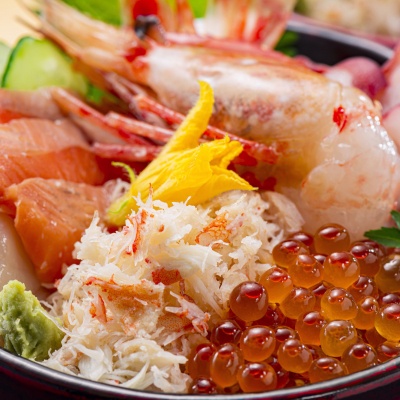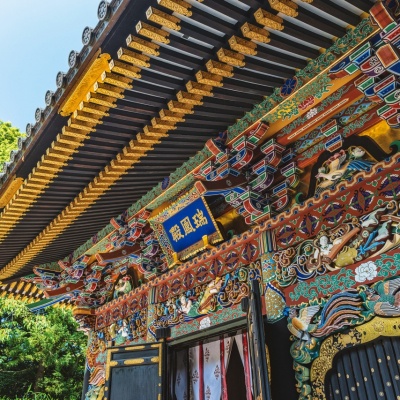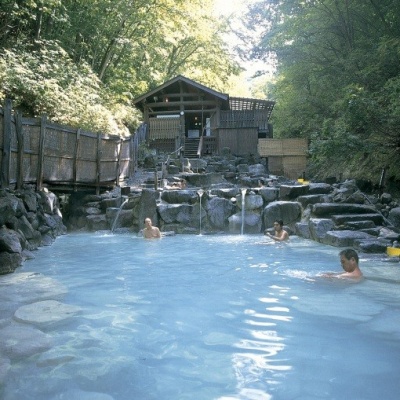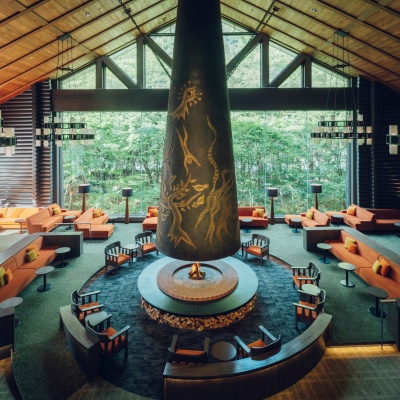3 days/2 nights based at Lake Tazawa, Nyuto, and Mizusawa Onsen [Base! Tohoku]

Nyuto Onsenkyo, a hidden hot spring resort, has seven hot springs scattered at the foot of the mountain. Enjoy visiting these hot springs.
Lake Tazawa, where there are many hands-on activities on the lake, and Kakunodate, with its Japanese atmosphere, are also nearby.
START
Day1
Lake Tazawa / The Statue of Tatsuko
Get spiritual at Japan’s deepest lake with mysterious cobalt blue water!

Lake Tazawa (Tazawako) is a stunning lake in Akita and has been selected as one of the 100 most scenic spots in Japan.
It is the deepest lake in Japan, with a depth of 423.4 meters. The surface of the lake changes from brilliant lapis lazuli to azure to indigo and is worth seeing. Take a cruise on a sightseeing boat, or take a paddle boat, canoe, kayak, SUP to enjoy the waters of the lake. It is also worth cycling, trekking, or driving along the lakeside to see the colors change across the lake. For those who want to stay longer, set up camp and see the changes with the time of day.
The Statue of Tatsuko is a golden female statue which stands against the backdrop of this magnificent lake. It is a famous spot by Lake Tazawa erected based on a legend that once upon a time, a girl named Tatsuko, who wished to keep her beauty forever, turned into a dragon and threw herself into Lake Tazawa. But there is more to this legend. In Hachirogata, or Hachiro Lagoon, there was a man named Hachiro Taro transformed into a dragon, and he fell in love with Tatsuko. As the two began to live together in Lake Tazawa, the lake became deeper and deeper without freezing in winter. In contrast, Hachiro Lagoon became shallower and shallower with each passing year when its master disappeared.
There are three statues associated with the Tatsuko Legend; the others being Tatsuko Kannon on the east shore of the lake and Tatsuko Hime (Princess Tatsuko) on the grounds of the Gozanoishi Shrine. Ukiki Shrine, located right next to the Statue of Tatsuko, is a power spot for marriage. Gozanoishi Shrine, which enshrines Tatsuko Hime no Kami as its main deity, is said to be bring beauty. The red torii gate is a popular photo spot.
It is the deepest lake in Japan, with a depth of 423.4 meters. The surface of the lake changes from brilliant lapis lazuli to azure to indigo and is worth seeing. Take a cruise on a sightseeing boat, or take a paddle boat, canoe, kayak, SUP to enjoy the waters of the lake. It is also worth cycling, trekking, or driving along the lakeside to see the colors change across the lake. For those who want to stay longer, set up camp and see the changes with the time of day.
The Statue of Tatsuko is a golden female statue which stands against the backdrop of this magnificent lake. It is a famous spot by Lake Tazawa erected based on a legend that once upon a time, a girl named Tatsuko, who wished to keep her beauty forever, turned into a dragon and threw herself into Lake Tazawa. But there is more to this legend. In Hachirogata, or Hachiro Lagoon, there was a man named Hachiro Taro transformed into a dragon, and he fell in love with Tatsuko. As the two began to live together in Lake Tazawa, the lake became deeper and deeper without freezing in winter. In contrast, Hachiro Lagoon became shallower and shallower with each passing year when its master disappeared.
There are three statues associated with the Tatsuko Legend; the others being Tatsuko Kannon on the east shore of the lake and Tatsuko Hime (Princess Tatsuko) on the grounds of the Gozanoishi Shrine. Ukiki Shrine, located right next to the Statue of Tatsuko, is a power spot for marriage. Gozanoishi Shrine, which enshrines Tatsuko Hime no Kami as its main deity, is said to be bring beauty. The red torii gate is a popular photo spot.
Kakunodate Bukeyashiki (Samurai Residences)
Travel back in time to the Edo period in the “Little Kyoto of Tohoku”!

Kakunodate is a former castle town which flourished during the Edo period. Known as the “Little Kyoto of Tohoku”, the town is home to a district two-kilometres in radius consisting of samurai residences and traditional architecture popular with both domestic and international tourists. The samurai residences lining the town’s most famous street are nationally protected Traditional Buildings.
Though some of them are still functioning homes, the residences are open to the public so visitors can get a feel for the traditional samurai life. Tourists can travel back in time to the Edo period by strolling around the traditional streets in an antique Kimono from one of the rental stores in town! A rickshaw ride from the Kakunodate Denshokan Museum will enhance the experience.
The town is charming throughout the year with springtime cherry blossoms, verdant summer greens, colourful autumn leaves and snowy winter scenes. Springtime is particularly popular with people coming for cherry blossom viewing from late April to early May. The traditional district features a row of weeping cherry blossom trees whose pink flowers bloom in beautiful contrast with the black walls of samurai residences, 162 of the 400 weeping cherry trees are designated natural treasures.
The samurai district is a 15 to 20-minute walk from JR Kakunodate station. Be sure to pick up the handy map and brochures available at the tourist information centre, located in a building resembling a traditional storehouse in front of the station!
A thematic journey in the Tohoku region:Castles・SamuraiA thematic journey in the Tohoku region:Flowers
Though some of them are still functioning homes, the residences are open to the public so visitors can get a feel for the traditional samurai life. Tourists can travel back in time to the Edo period by strolling around the traditional streets in an antique Kimono from one of the rental stores in town! A rickshaw ride from the Kakunodate Denshokan Museum will enhance the experience.
The town is charming throughout the year with springtime cherry blossoms, verdant summer greens, colourful autumn leaves and snowy winter scenes. Springtime is particularly popular with people coming for cherry blossom viewing from late April to early May. The traditional district features a row of weeping cherry blossom trees whose pink flowers bloom in beautiful contrast with the black walls of samurai residences, 162 of the 400 weeping cherry trees are designated natural treasures.
The samurai district is a 15 to 20-minute walk from JR Kakunodate station. Be sure to pick up the handy map and brochures available at the tourist information centre, located in a building resembling a traditional storehouse in front of the station!
A thematic journey in the Tohoku region:Castles・SamuraiA thematic journey in the Tohoku region:Flowers
Semboku City Kakunodate Kabazaiku Center (Cherry Bark wood Craft Heritage Center)
Unique crafts using Yamazakura cherry bark, that are unparalleled in the world
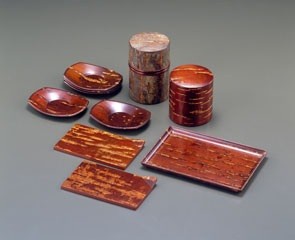
Kabazaiku is a craft made using the bark of Yamazakura cherry trees. This traditional craft features an austerely elegant and deep colour that makes use of the tree's unique luster. It is used to make items such as tea leaf caddies and other tea utensils, writing boxes, tea cabinets, brooches, and tie pins using techniques that have been handed down since ancient times in Kakunodate. The bark has a quality that blocks out moisture and prevents drying, and is particularly suited for tea leaf caddies.
The Semboku City Kakunodate Kabazaiku Center has a kabazaiku craft exhibition room, and also holds kabazaiku demonstrations. There is also a workshop where you can make your own small kabazaiku hanging scroll, so why not try your hand at making your own souvenir?(Reservations required: Senboku City Exchange Design Division Tel. 0187-43-3353)
The Semboku City Kakunodate Kabazaiku Center has a kabazaiku craft exhibition room, and also holds kabazaiku demonstrations. There is also a workshop where you can make your own small kabazaiku hanging scroll, so why not try your hand at making your own souvenir?(Reservations required: Senboku City Exchange Design Division Tel. 0187-43-3353)
Dakigaeri Valley
A scenic gorge with a mystical cobalt blue stream particularly popular when surrounded by summer greens and autumn foliage

Dakigaeri Valley, with its beautiful and mysterious azure mountain streams, is also known for its fresh greenery and autumnal foliage. It was named "Dakigaeri" because the mountain path was so narrow and steep that people had to hold on to each other to pass each other.
The best season to visit is from mid-June to late August when the leaves are fresh green, and from early October to early November when the leaves turn red. Many people come to visit during the Dakigaeri Autumn Leaves Festival held during the season to see performances and tea ceremonies.
There is a path along the river to enjoy a casual stroll. It takes around 30 minutes and is a 1.5-km one-way course with few ups and downs. The Kami no Iwahashi (rock bridge of God), located a 2 to 3 minutes' walk from Dakigaeri Shrine at the entrance of the path, is a major scenic spot of this valley. The contrast between the red suspension bridge and the emerald green surface of the water is an absolutely beautiful sight.
From there, beyond the scattered rocks, such as Mikoishi, Goza no Ishi, and Taishaku no Iwaya, you will find Seigan Bridge, a popular photo spot with rock walls on both banks looming over the cobalt blue river surface. After passing through three tunnels, you will come to Mikaeri no Taki, a waterfall with a beautiful view of the river. The name "Mikaeri" comes from the fact that you will want to look back again and again.
Further down from the Mikaeri No Taki Falls you can come across the limura Boy Memorial, a statue of a Jizo and a monument.
*Please note that the trail is usually closed from late November to late April due to snow.
The best season to visit is from mid-June to late August when the leaves are fresh green, and from early October to early November when the leaves turn red. Many people come to visit during the Dakigaeri Autumn Leaves Festival held during the season to see performances and tea ceremonies.
There is a path along the river to enjoy a casual stroll. It takes around 30 minutes and is a 1.5-km one-way course with few ups and downs. The Kami no Iwahashi (rock bridge of God), located a 2 to 3 minutes' walk from Dakigaeri Shrine at the entrance of the path, is a major scenic spot of this valley. The contrast between the red suspension bridge and the emerald green surface of the water is an absolutely beautiful sight.
From there, beyond the scattered rocks, such as Mikoishi, Goza no Ishi, and Taishaku no Iwaya, you will find Seigan Bridge, a popular photo spot with rock walls on both banks looming over the cobalt blue river surface. After passing through three tunnels, you will come to Mikaeri no Taki, a waterfall with a beautiful view of the river. The name "Mikaeri" comes from the fact that you will want to look back again and again.
Further down from the Mikaeri No Taki Falls you can come across the limura Boy Memorial, a statue of a Jizo and a monument.
*Please note that the trail is usually closed from late November to late April due to snow.
Nyuto Onsenkyo
These seven hidden hot springs nestled in the mountains are a must visit!

Nyuto Onsenkyo is a hot spring town famous throughout Japan for its hidden hot springs. The area consists of seven hot spring resorts, each with its own unique hot spring source. Since there is a wide variety of spring qualities and inns, it is recommended to enjoy each one by visiting the various hot spring baths.
For 600 yen, you can purchase a Yumeguri Map for unlimited rides on the Yumeguri-go bus that circles around Nyuto Onsenkyo for one day, making it a convenient way to get around. Guests can purchase a Yumeguri-cho booklet for 1,800 yen, which includes bathing fees for the seven hot springs. Both are available at the front desk of each inn.
For 600 yen, you can purchase a Yumeguri Map for unlimited rides on the Yumeguri-go bus that circles around Nyuto Onsenkyo for one day, making it a convenient way to get around. Guests can purchase a Yumeguri-cho booklet for 1,800 yen, which includes bathing fees for the seven hot springs. Both are available at the front desk of each inn.
Day2
Hachimantai Aspite Line / Snow Corridor
Enjoy the incredible snow walls and cherry blossoms in Towada-Hachimantai National Park!
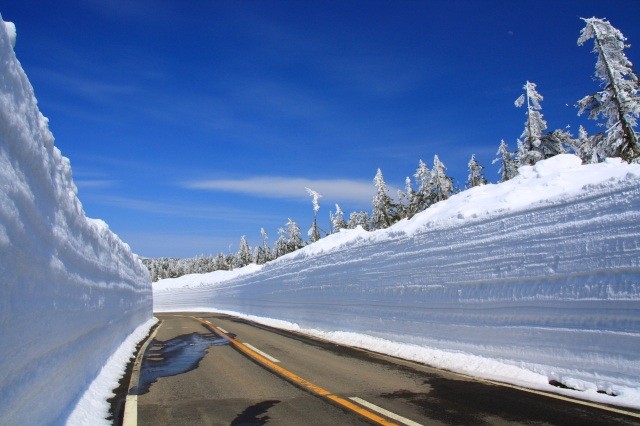
Mount Hachimantai is a mountainous plateau rising 1,613m above sea level stretching over Iwate and Akita prefectures. The Hachimantai Aspite Line is a 27km driving route traversing Mount Hachimantai from the Gozaisho Wetlands to Toroko Onsen. The driving route is closed during winter (early November to mid-April) after which it is lined by snow walls, known as the Snow Corridor, formed by snowploughs cutting through the deep snow drifts.
Many people come here to enjoy the scenic drive when the line reopens in mid-April, when hoar frosts can also be seen. This unique scenic drive can be enjoyed until early May. Along the 27km Snow Corridor, the longest in Japan, the snow walls rise up to 8m as the road stretches up the mountain.
Visitors can also enjoy cherry blossom viewings at the foot of Mount Hachimantai after the unique drive along the Snow Corridor. The “Cherry Blossoms and Snow Corridor” sightseeing bus is available during the blossom season.
The rest house at the top of Mount Hachimantai offers splendid panoramic views.
The nearby Toshichi Onsen is the perfect place to have a relaxing break while driving in the mountains.
Many people come here to enjoy the scenic drive when the line reopens in mid-April, when hoar frosts can also be seen. This unique scenic drive can be enjoyed until early May. Along the 27km Snow Corridor, the longest in Japan, the snow walls rise up to 8m as the road stretches up the mountain.
Visitors can also enjoy cherry blossom viewings at the foot of Mount Hachimantai after the unique drive along the Snow Corridor. The “Cherry Blossoms and Snow Corridor” sightseeing bus is available during the blossom season.
The rest house at the top of Mount Hachimantai offers splendid panoramic views.
The nearby Toshichi Onsen is the perfect place to have a relaxing break while driving in the mountains.
Hachimantai Dragon Eye (Kagami-Numa Lake)
Hachimantai Dragon Eye, a natural phenomenon that appears in a lake
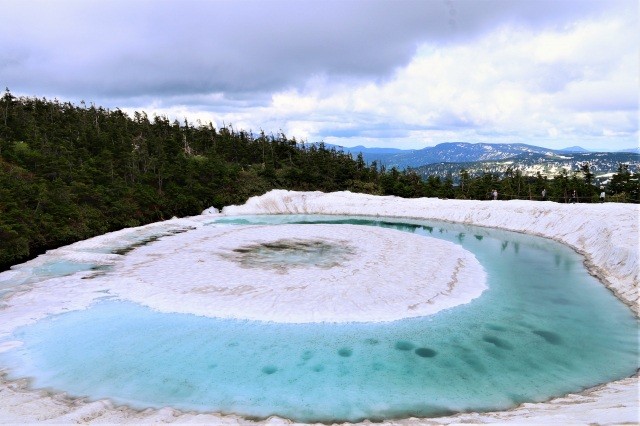
The Hachimantai Dragon Eye is a mysterious sight caused by a natural phenomenon of Kagami-Numa Lake, located near the summit of Mt. Hachimantai from late May to early June. The snow falls and piles up over the lake during winter. When the spring comes and it starts to thaw, the snow in the middle creates a ring. Then the sunlight and the color of the sky shines on it, creating the Dragon Eye. Near Kagami-Numa Lake is the emerald-green Megane-Numa Lake, which has recently been dubbed the “Tears of Dragon” and is popular among tourists along with the Dragon Eye. The area around Kagami-Numa Lake, where you can easily take a stroll while straddling the border between prefectures, has many craters created by steam explosions, and you can see many swamps such as the Hachiman-Numa Lake and the Gama-Numa Lake, whose water accumulates in these craters. The view from the observatory is also recommended. Be sure to enjoy the vast panorama of nature when you visit.
After seeing the dragon eye, stop by some nearby places to eat and enjoy beautiful seasonal views.
The information center of Hachimantai Dragon Eye
A thematic journey in the Tohoku region:Snowmelt
After seeing the dragon eye, stop by some nearby places to eat and enjoy beautiful seasonal views.
The information center of Hachimantai Dragon Eye
A thematic journey in the Tohoku region:Snowmelt
Mizusawa Onsenkyo (Senboku City, Akita Prefecture)
Day3
Odate-Kosaka Rail Bike
Have fun pedalling along the clackety railroad tracks

Odate-Kosaka Rail Biking involves riding a “rail bike” that you pedal like a bicycle on top of the abandoned tracks of the former Kosaka Railway. It’s a new sensation to feel the clackety vibration beneath your feet as you pedal forward! This is an activity that will hugely delight railroad fans and children alike.
The round trip journey is about 4 kilometres and takes up to about 30 to 40 minutes. The ascent is great exercise, but coming back is refreshing as you descend in a rush! The moment when you cross a railroad bridge midway is thrilling. You can also enjoy scenery of the grandeur of nature. People who don’t feel confident in their body strength can also breath easy with an electric assist bicycle that supports pedalling.
The round trip journey is about 4 kilometres and takes up to about 30 to 40 minutes. The ascent is great exercise, but coming back is refreshing as you descend in a rush! The moment when you cross a railroad bridge midway is thrilling. You can also enjoy scenery of the grandeur of nature. People who don’t feel confident in their body strength can also breath easy with an electric assist bicycle that supports pedalling.
GOAL
